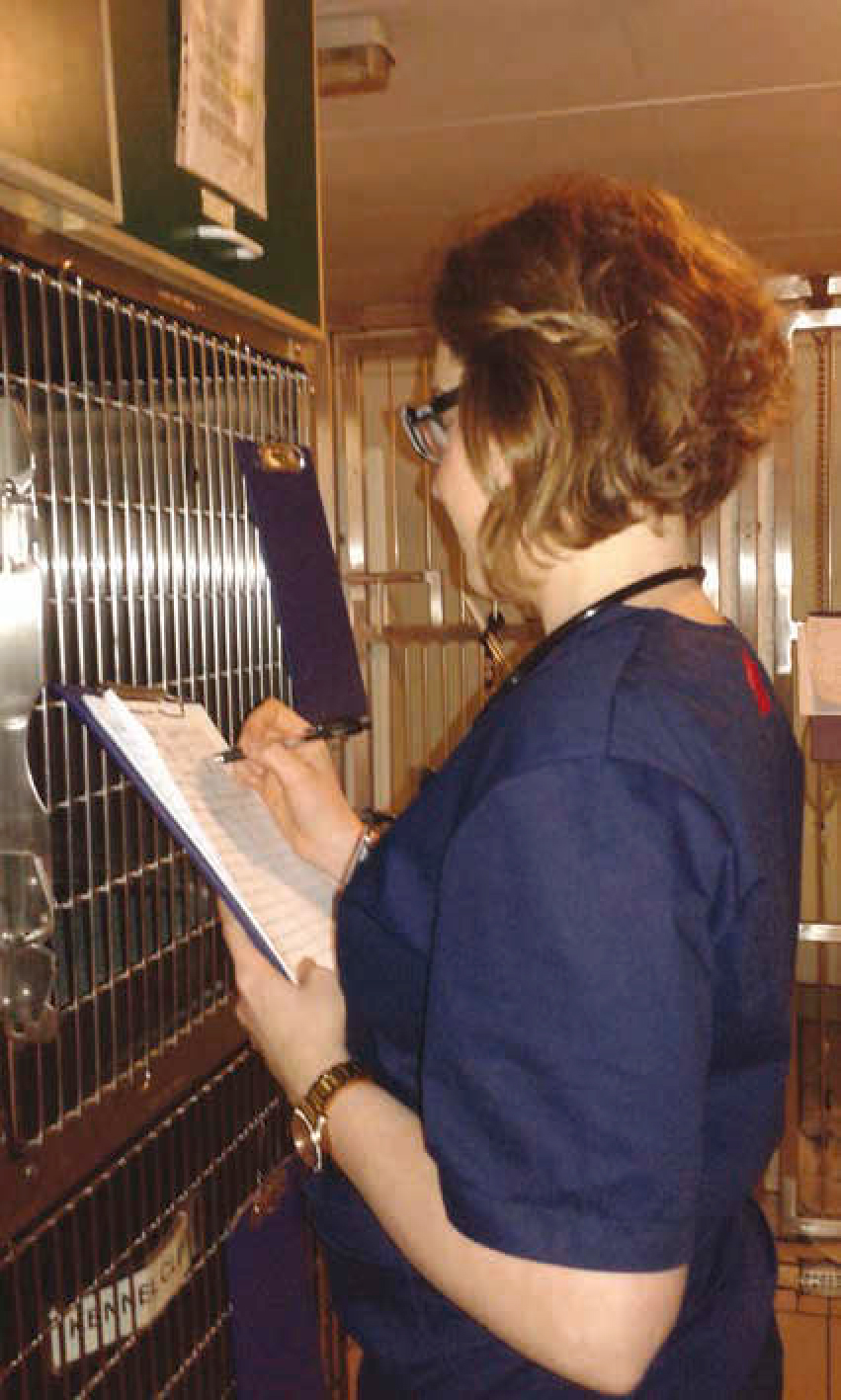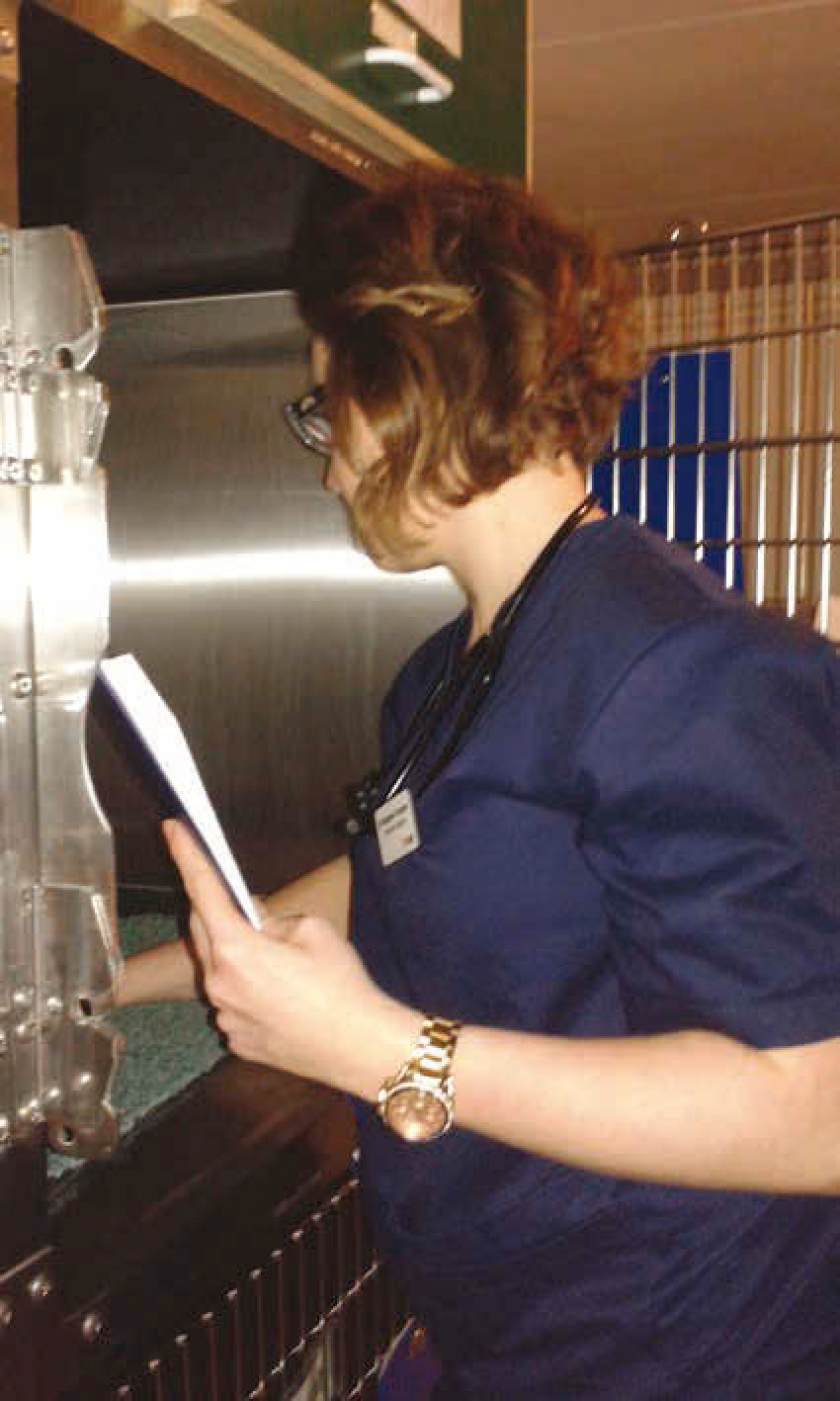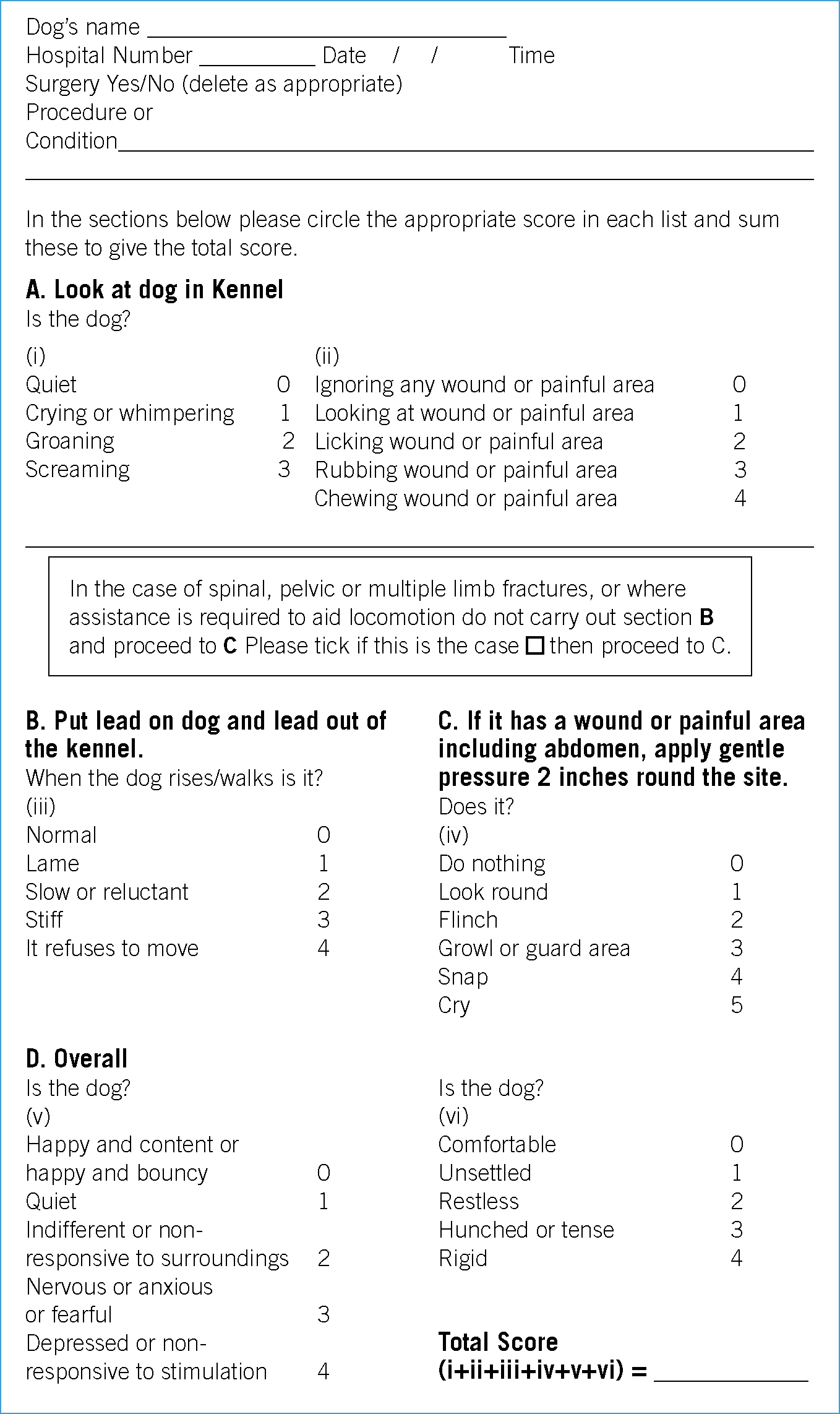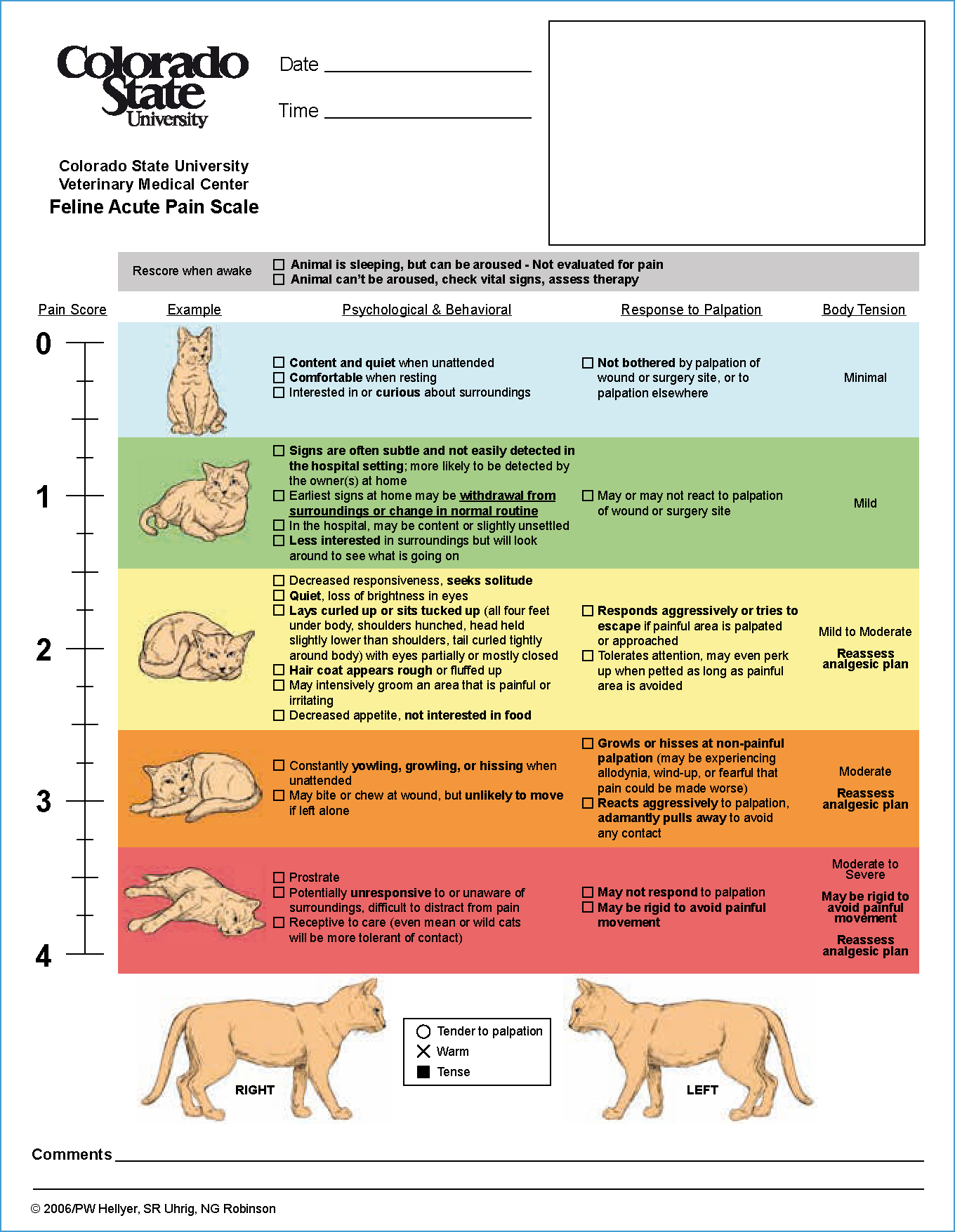Within a veterinary practice pain assessment is considered to be one of the most important yet challenging aspects of veterinary care, fundamental to patient wellbeing. This area of patient care was relatively neglected until 2004 when veterinary medicine started to progress (Morton et al, 2005; Ambrose, 2013). The ability to feel pain is a very individual experience in humans, therefore the same principle should be applied to veterinary medicine. While one patient may not present any signs of pain another may do following the same procedure. This highlights the importance of individual assessment and a holistic approach to allow for provision of a high standard of patient care (Ambrose, 2013). There are many pain scoring systems available that have been adapted for use within veterinary practice, as well as those that have been devised specifically for this purpose, which can be utilised to assist in achieving this standard. Inadequate analgesia is a welfare issue resulting in anorexia, decreased mobility, altered sleeping and behavioural patterns, delayed wound healing, patient interference and overall delayed recovery (Webber et al, 2012; Crompton, 2014). It is therefore highlighted that pain management should be a priority with every patient to avoid serious implications on patient health.
Physiological assessment of pain
Pain is a sensory and emotional response, therefore this would indicate that assessment of both areas should be considered during pain assessment by incorporating both physiological and behavioural observations. Use of physiological measurements however has been argued by some to be unreliable (Barratt, 2013; Crompton, 2014). The variable rating scale (VRS) is available which incorporates physiological assessment, such as heart rate and temperature, with a score given for each section, this is then combined to give an overall pain score. Although Grant (2006) described this scale as sensitive and reliable, even when used by multiple assessors, Ambrose (2013) suggested that although certain physiological changes can occur due to pain, these signs should not be solely relied on. He claimed that despite a risk of behavioural and survival characteristics masking signs of pain, behavioural assessment should still be incorporated. For example tachycardia may be a response to fear and stress and the registered veterinary nurse (RVN) must be able to differentiate between such a response and reactions to pain (Williams, 2010).
A study of 80 canines by Holton et al (1998) concluded that physiological findings were not reliable indicators of pain in canines. This study recorded heart rate, respiration rate and pupil dilation alongside a behavioural assessment scale and no associations with physiological signs and behavioural signs were shown. There was an indication of association between pupil dilation and pain, seen similarly in humans, however further research is required into this area as the range of pain scores allocated to both dilated and undilated pupils were the same, questioning the reliability of the assessment. Therefore despite the difference in distribution for each group the researchers deemed these results to be unreliable. None of the observers in this study had any training on the use of the scale. This was a relatively large study divided into four groups including orthopaedic and soft tissue surgery patients, therefore involving a range of surgeries and pain responses. It also included two groups which were determined by veterinary surgeons (VS) to be showing no current signs of pain, therefore providing a baseline to directly compare results.
A smaller study by Firth and Haldane (1999) on 36 canines following ovariohysterectomy, again providing a baseline by using a comparison of patients having an anaesthetic with no surgery, did show reliability in the use of physiological measurements in the assessment of response to analgesia post-operatively. This study suggested that heart and respiration rate can be reliable signs of pain. In this study assessors were trained in use of the pain measuring scale — this study also, therefore, highlights that training in the use of such scales is vital for a reliable outcome and with efficient training this scale could prove to be a valuable tool.
Behavioural assessment of pain
Assessment of analgesia requirement in human nursing faces fewer challenges than in veterinary nursing because human patients are able to report pain themselves. However, neonatal nursing in human medicine faces similar barriers to those seen in veterinary nursing, and implementation of behavioural assessment in this group has proven reliable (Barratt, 2013). Behavioural signs may be due to physical impairment due to surgery or illness, they may be protective and some patients may adopt a coping strategy to reduce pain (Hansen, 2003). Hall (2015) suggested that behavioural signs of pain include changes in body posture, such as a hunched back and lateral recumbancy, changes in demeanor, vocalisation and a change in reaction to being handled. A survey of 50 veterinary practices by Webber et al (2012) showed similar opinions from a range of VSs, and concluded that the most common sign of pain is demeanor followed by vocalisation, with respiration rate shown to be the most sensitive. This again supports the opinion that physiological assessment should be incorporated into any pain assessment scoring system. The results suggested that to achieve a valid evaluation of pain monitoring physiological, behavioural and body functions should be assessed.
Research is also developing into the use of facial expressions in felines to detect signs of pain. Results following a study by Holden et al (2014) highlighted the landmarks deemed to be most reliable were the ears, mouth and nose and the use of measurements determined if the patient was painful or pain free. This is relatively new research and research in the area is ongoing.
The use of patient interaction is discussed by Barratt (2013) who advised using a four staged pain assessment when relying on behavioural assessment. First, observing the patient from outside the kennel (Figure 1), then opening the cage and encouraging the patient to interact (Figure 2), followed by response to touch and wound palpation, and finally physiological measurements. This allows for a thorough assessment and aims to avoid signs of pain being masked. The use of the dynamic and interactive visual analogue scale (DIVAS) which incorporates these assessments was proven successful in a study by Shih et al (2008) which concluded that pain was only highlighted following interaction and that when just using observation alone analgesic requirements were not recognised. This was a large study consisting of 60 canines undergoing the same surgery and the scale proved reliable and when used in comparison with the Glasgow Composite Pain Scale (GCPS) similar results were shown. Orpet and Welsh (2011) agreed that observation alone is not effective in determining whether an animal is in pain, and that patient interaction is vital, however this was disputed by Vettorato and Bacco (2011) due to interaction causing stress and a release of catecholamines thus reducing the analgesic efficiency of drugs.


Pain scoring systems
Visual analogue scale
There are many pain scoring systems available and adapted for use within veterinary practice that rely on behavioural assessments using subjective rating systems, although there is much discussion about their reliability, especially when sedation or anaesthesia may also have an effect on behaviour (Crompton, 2014). The visual analogue scale (VAS) is regularly used for the assessment of post-operative pain management in animals. This uses a line scale with one being no pain and 10 being extreme pain and a mark is placed on the line according to where the RVN feels the animal's pain should be placed following observation.
There are concerns that the VAS scale can be over interpreted, highlighting that training is essential, suggesting its use as fairly complicated (Crompton, 2014). This was shown in a study by Benito-de-la-Vibora et al (2008), a large study consisting of 69 felines all undergoing the same procedure (ovariohysterectomy), which reduced the variables. The study was devised to analyse analgesia protocols and used the VAS scale, alongside the numeric rating scale (NRS). The NRS uses scores of one to 10 with one being pain free and 10 being extreme pain. No training was provided on the VAS scale and no significant difference was shown between the placebo and treatment groups using this scale in comparison to the NRS scale. The study concluded that the lack of a difference seen between the placebo and treatment groups was due to lack of training, required due to the scales complicated use, and the lack of sensitivity in the scale when considering the various presentations of pain seen in feline patients. Only one assessor was involved therefore the use of opinion was limited and different results may have been shown with multiple assessors trained in the use of the scale.
Holton et al (1998) however believed that these scores could be influenced by motor and visual coordination of the observer, highlighting accuracy concerns with multiple observers, and Hansen (2003) also suggested variability with multiple observers. A smaller study conducted by Carpenter et al (2004) consisting of 30 canines following the same surgery found the VAS to be reliable with use of one assessor experienced with its use, suggesting again that multiple assessors would increase variability. The conclusion could therefore be that training in the use of the VAS system is essential and that the use of multiple observers could produce unreliable scores.
The Dynamic Visual Analogue Scale (DIVAS) has been developed from the VAS incorporating the interaction assessment mentioned above. First the patient is observed from a distance followed by approach, handling, wound palpation and finally walking with each having a score rated. A combination of visual assessment, interaction and wound palpation is also used in the simple descriptive scale (SDS) and has been described as the simplest scale available to use within veterinary practice (Grant, 2006; Crompton, 2014). This scale uses simple descriptive steps to allow for pain assessment. However it was implied by Grant (2006) that this would allow for small changes in pain to go undetected and the scale may have a lack of sensitivity with the potential of variation between different observers. In comparison to the VAS and SDS the NRS is more efficient when there are multiple RVN assessors (Crompton, 2014). It has proven more successful in identifying small variations in pain when compared with the descriptive scale used in the SDS and the line scale used in the VAS (Crompton 2014).
Composite scales
More recently there have been scales devised specifically for veterinary use. These are composite scales considering multiple factors and assigning a numerical scale, moving away from the unidimensional scales discussed above (Williams, 2010; Murrell, 2014). A good composite scale should assess severity of pain and behavioural and physiological responses with consideration of other factors that may mask these signs of pain (Williams, 2010). The Glasgow Composite Pain Scale (GCPS) (Figure 3) has been developed from the human McGill pain assessment questionnaire which consists of six sections regarding different pain assessments. A score is given for each section which when combined, give an overall pain score. This scale has now been developed for both canines and felines and has been described as a reliable tool in post-operative pain assessment following various types of surgery (Crompton, 2014). This scale can be used with both recumbent and ambulant patients, although it can present challenges when differentiating between signs of pain and sedation (Murrell, 2015). Similarly the Colarado State University has developed a pain scoring system for both species, the Colorado Composite Pain Scale (CCPS) (Figure 4), incorporating images to show differing postures and expressions as a guideline to the descriptions given for each score (Barratt, 2013). Both scales measure sensory and emotional responses to pain and incorporate behavioural observation, interaction and wound palpation (Murrell, 2015). These composite scales outline clear descriptions of pain, similar to SDS but with much more detail, therefore reducing the risk of reduced sensitivity. They can be used by multiple observers giving reliable results and have few time restraints, an advantage as lack of these factors has affected the accuracy of other systems (Murrell, 2015). Murrell (2014) suggested, however, that the CCPS had limitations due to its simplicity compared with the Boutucatu Multidimensional Pain Scale (BMPS) also designed for use in cats (http://www.animalpain.com.br/assets/upload/escala-en-us.pdf). The BMPS is divided into 3 sections: pain expression; psychological variables; and physiological changes, and has been validated for its use unlike the CCPS (Murrell, 2014). Murrell (2014) however suggested use of the BMPS can be complex and that the CCPS could be a good starting point when considering new implementation in practice.


In consideration of the veterinary specific designed pain scoring systems available a large blinded study by Al-Gizawiy and Rude (2004) suggested that the CCPS was unreliable in felines when considering over activity immediately post operatively and with stimulation from other felines in the ward. It also stated how vital interaction with the patient and palpation of the wound were to establishing a reliable pain score. This was a reliable study with reduced variability as all felines underwent the same surgery and were assessed by the same observer. Calvo et al (2014) also suggested the CCPS to be invalid and unreliable in comparison to the GCPS which was designed following psychometric principles incorporating validity and reliability testing. A study by Carsen et al (2008) utilised the GCPS and the VAS for assessments of pain in radiation patients and found them both to be reliable tools. Similar to the Al-Gizawiy et al (2004) study there was suggestion that anxiety had influenced results. Carsen et al's (2008) study was a small study using two observers who were not blind to the patients and there were concerns of multiple observer issues, therefore this was not a reliable study. It did however conclude that the two scales worked well in conjunction with each other with the VAS detecting more subtle signs of pain. A similar study by Aghighi et al (2012) studying the effects of gabapentin on seven canines following disc surgery stated that the GCPS was unable to detect any analgesia effects and showed a weak correlation when compared with results from a VAS system. The suggestion of this was a lack of interaction with the VAS and a more detailed description with the GCPS. In contrast to the Carsen et al (2008) study, in this case no patients were on current medication and there was only one observer highlighting the reliability of this study in comparison.
Additional studies
Results of a study by Raekallio et al (2003) concluded that women and younger veterinary professions recorded higher pain scores than males and those that had been in the profession for an extensive duration, suggesting a more sensitive approach to pain in their patients. A study conducted in the UK in 2007 by Coleman and Slingsby (2007) revealed that only 8.1% of the practices involved currently had a pain scoring system in place. Similar results were shown in a French study conducted by Hugonnard et al (2004) with 73.4% not having implemented pain scoring systems, 45% of VSs stated they were concerned about their personal recognition of pain and more than 50% believed their analgesia use in felines was inadequate when compared with canine analgesia. The domestic cat is one of the most poorly understood species regarding pain recognition and historically analgesia has not been met adequately in comparison to canines (Wright, 2002; Al-Gizawiy et al, 2004; Barrett 2013). There are limited analgesia drugs approved for use in felines due to the increased risks of toxicity as a result of the inability to perform glucuronidation and the respiratory depression caused by opioids (Welsh 2003; Al-Gizawiy et al, 2004). A more recent study by Webber et al (2012) highlighted that both VSs and RVNs considered analgesia as an area requiring improvement, suggesting that there has been little progression in this area. It also highlighted a requirement for further training on pain assessment with 96% of RVN participants feeling their knowledge in this area could be enhanced.
The RVN
In 2010 veterinary nursing became a registered profession making veterinary nurses accountable for their actions and increasing their responsibility within the profession (Bloor, 2011). RVNs now have a duty to ensure that they are performing tasks correctly and at a high level to achieve the highest standards of nursing care possible by following a Code of Professional Conduct. This states that RVNs must make animal health and welfare the first consideration with the patients in their care (Royal College of Veterinary Surgeons, 2015). As inadequate analgesia has considerable welfare implications on patient wellbeing clear knowledge and understanding of pain assessment and pain recognition is essential, and pain scoring systems can be utilised as efficient tools to achieve and maintain this standard. The regulation also requires RVNs to maintain and continue to develop knowledge and skills within their clinical practice based profession. This ensures that the best decisions and desirable outcomes are achieved, allowing implementation of new ideas to improve nursing standards (Bloor, 2011; Clarke, 2012).
Implementation
The use of a pain scoring system has the potential to improve pain assessment and increase overall standard of nursing care. When considering implementation of a system within veterinary practice it is vital that it is reliable and user friendly while having restricted time constraints, creating a positive impact on RVNs and encouraging improvement in pain assessment (Ambrose, 2013). All staff members utilising the system should be fully trained to ensure efficient use and it has been shown in practice that following an increase in nursing staff and an increase in training and knowledge of the pain scoring system, pain management improved (Shaffran, 2008). Once implemented the pain scoring system should be reviewed and feedback evaluated so that it can be adjusted to meet the needs of the practice (Barratt, 2013). It is vital to remember that each patient and their response to pain is individual and that these assessments should be evaluated and repeated at regular intervals. Hall (2015) suggested performing post-operative pain assessments every 15–30 minutes in the early stages of recovery and then hourly for the following 6–8 hours. However it is important to ensure anaesthesia drugs are not showing false results (Shaffran, 2008). Ideally the same RVN should carry out the assessments to achieve continuity, but good communication skills between RVNs is essential to ensure all information is received (Hall, 2015). A trusting relationship between RVN and VS is also vital and without good verbal and written communication patient care could be compromised. This requires the VS to trust the RVN and their decisions. Communication can be improved with increased knowledge of pain physiology and pharmacology of the analgesia drugs administered (Shaffran, 2008). It has been shown that 71% of VSs will delegate post-operative monitoring of analgesia to RVNs, however despite this 68% felt that the RVN had insufficient knowledge of pain assessment (Barratt, 2013). This means there is often frustration for RVNs when requests for further analgesia are ignored (Shaffran, 2008) and pain scoring systems can be utilised to justify findings to increase the VSs trust in the RVN's judgment (Shaffran, 2008).
Behavioural changes caused by stress should be considered as it has been shown that heart rates and respiratory rates of anaesthetised cats that underwent surgery were no different to those recorded in cats that did not undergo surgery (Wright, 2002). This suggests that factors other than pain, such as stress and anxiety, had caused the increase in heart and respiration rates. Breed-related behaviours can also mask signs of pain, for example in comparison to a Greyhound a Labrador may be more energetic, and a Staffordshire Bull Terrier may be more vocal (Hall, 2015). Therefore patients should be assessed pre-operatively so that the RVN is aware of normal individual behaviour and behavioural changes developing from being in a stressful environment (Hall, 2015). It is also useful to discuss normal behavioural patterns with the owner prior to hospital admission. This can help to create a stress free environment reducing anxiety, therefore allowing for a more accurate assessment, as well as providing an opportunity for owners to mention any pain already presented. Raekallio et al (2003) mentioned concerns with owners being able to accurately interpret signs of pain, but suggested that any behavioural changes can be detected that may be linked to pain. This also highlighted how important interaction and wound palpation are in delivering reliable assessments of pain (Wright, 2002). Wright (2002) discussed creating a table of presumed diagnosis of pain as a baseline to allow for a prediction of pain to be estimated, for example it is assumed a disc herniation would be more painful than a castration. This also allows for accurate administration of analgesia pre-emptively.
Conclusion
Both physiological and behavioural signs are accurate measurements of pain and patient interaction is essential when monitoring pain in veterinary patients. This suggests that overall all three methods of assessment are required to achieve a high standard of pain assessment: physiological measurements, behavioural assessment and patient interaction. Factors such as stress, anxiety and sedation may produce false results and therefore when all three factors are used in combination a clear assessment can be achieved. Following observation the patient should be encouraged to interact and palpation of the wound should be conducted when possible. Consideration of instinct and breed-related behaviour should be given and a pre-operative assessment would provide a beneficial baseline for assessment.
It has been discussed that both the GCPS and CCPS can be used by multiple assessors and the GCPS has shown reliable results following implementation and is a validated system. Advantages have also been shown when the GCPS is used alongside the VAS suggesting a combination of use. The CCPS has not been validated and its reliability has been questioned due to lack of sensitivity with descriptions of pain. It has however been suggested that this scale can be a good starting point prior to implementation of the more specific and validated, but also complex BMPS.

